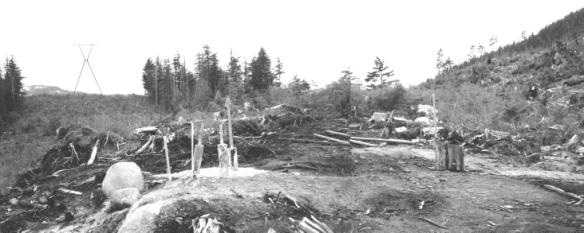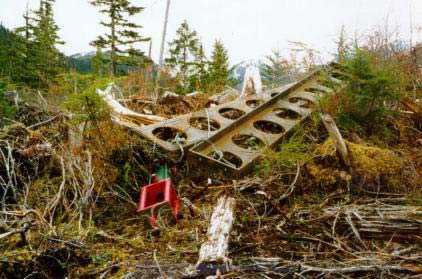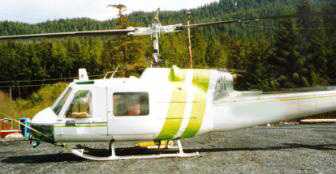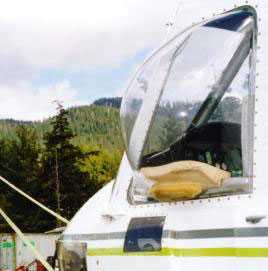Laborer/rigger Electrocuted During an Aerial Lift of Equipment
Alaska FACE Investigation 99AK011
January 24, 2000
SUMMARY
A 38-year old laborer/rigger was electrocuted when a cable attached to a helicopter contacted an overhead power transmission line. The laborer/rigger (the victim) and a coworker had completed their assignment of testing new foundation anchors, located below a set of three transmission lines energized to 69 kV. They had just finished moving and attaching rigging cables to two steel beams. The ground crew used a radio in a truck on a nearby access road to request the aerial lift. The transport staging area was 15-20 feet east of the north-south running transmission lines. A helicopter with an attached non-retractable 111-foot cable arrived and hovered. The wind direction was from the east, placing the helicopter upwind from the lines. As the helicopter maintained a heading nearly parallel to the lines, it descended to place the hook and 5-7 feet of the cable on the ground approximately 10 feet south of the load. The co-worker picked up the hook and brought it underneath the helicopter to the beams where the victim was holding the attached rigging cables. Once attached, the co-worker turned to move away from the load and the helicopter. He heard a crack after taking a few steps. He turned and saw the victim stagger away from the beams and collapse. Simultaneously, the helicopter crew heard a crack and saw a flash. The pilot moved the helicopter away from the lines, lifting the load and dropping it nearby. The co-worker then went to assist the victim. Unable to get any response, he ran to a truck to radio for help. Another co-worker standing near the truck went back to the victim and started CPR.
After landing the helicopter a short distance away, the pilot exited the aircraft to check the victim's condition. The co-pilot took command of the helicopter and went to retrieve an emergency medical technician (EMT) employed by the company. Several minutes later, the helicopter returned with the EMT. The co-pilot then flew to a refueling area to bring a helicopter with a transport litter to the incident site. The victim was transported to a local medical facility where he was pronounced dead.
Based on the findings of the investigation, to prevent similar occurrences, the employer should:
- Ensure that all aerial lift staging areas are located outside a 20-foot safety zone around overhead power lines and are clearly marked;
- Ensure that an extended safety zone is used when aerial lifts cannot be done downwind of energized overhead power lines;
- Ensure that workers are provided with two-way radios for communicating with the helicopter pilot during aerial lifts;
- Ensure that a spotter is present to provide directions to the helicopter pilot during aerial lift operations and that they (the spotter and pilot) are familiar with both verbal commands and hand signals;
- Ensure that workers use insulated footwear and gloves while working near power lines;
- Ensure first aid plans minimize response times during emergencies;
In addition, helicopter operators and the helicopter aviation industry should:
- Consider using non-conductive cables when airlifting loads near overhead power lines;
- Consider developing and implementing safe operation guidelines for aerial lifts near overhead power lines.
INTRODUCTION
At 2:45 p.m. on May 5, 1999 a 38-year-old laborer/rigger (the victim) was electrocuted while assisting with a helicopter lift near a power transmission line. On May 6, 1999 Alaska Department of Labor (AKDOL) notified the Alaska Division of Public Health, Section of Epidemiology. An investigation involving an injury prevention specialist for the Alaska Department of Health and Social Services, Section of Epidemiology ensued on May 6, 1999. The incident was reviewed with AKDOL officials. Alaska State Troopers, Medical Examiner, and AKDOL reports were requested.
The contractor in this incident was a joint venture between a private construction company and a company consisting of several public utility subsidiaries. The two companies entered into an agreement for a transmission line improvement project in September 1998. The project entailed building additional support towers for 138-kV transmission lines and repairing the foundations of existing towers along a 45-mile range. At the time of the incident, the transmission lines were energized to 69 kV.
The private construction company had been in business since 1980. The company employed a total of 30 employees of which 26 were work crewmembers. The workers were assigned to one of four groups: three drill crews and one testing crew. Each crew consisted of at least two or three workers, of which one worker acted as the lead crewmember. Work assignments, specifying crew and worksite location along the transmission line, were distributed each morning. Workers, equipment, and materials were transported to the worksites either by helicopter or by truck. The victim had been employed by the company as a laborer/rigger for one month and was assigned to the testing crew. At the time of the incident, the victim and his co-worker, who had also been employed by the company for one month, were rigging a load to be airlifted to the next assigned site.
The company had a written and comprehensive safety program. Upon initial hire, employees were given a safety pamphlet and a safety orientation using a checklist that was later filed in the employee's personnel record. Personal protection equipment (PPE) was provided to workers and included, but was not limited to, hardhats, gloves, orange vests, and safety glasses. Two-way radios were installed in the company's trucks but were not issued to individual workers. Safety meetings were conducted weekly. Written job safety analyses were performed for each assigned task including anchor testing, mobilization/demobilization of equipment and materials to drill site, and working near transmission lines. Company safety policy required all aerial lifts to be done 20 feet or more from energized lines and could be done without a supervisor present. However, a supervisor was to be notified and the site reassessed for any additional safety hazards for any aerial lift within 20 feet of energized lines.
INVESTIGATION
The incident occurred at a location on a remote hillside in southeast Alaska approximately 26 road miles from the company staging area. The transmission lines ran north-south along this section and linked a hydroelectric station to a nearby community utility. The incident site was on a slight slope, approximately 15-20 feet east of the transmission lines, and approximately 220 feet west from an access road. The terrain sloped down from the road and then rose up to the transmission line right-of-way (Figure 1). Ground conditions consisted of cut or slashed brush (Figure 2). At the time of the incident, weather conditions were high overcast with light rain and snow. Winds, as estimated by the helicopter pilot and co-pilot, were from the east at 6-12 MPH with gusts up to 15 MPH. The helicopter was operated under visual flight rules, and reduced visibility was not considered a factor in this incident.

Figure 1. Diagram of staging area (Not to scale)

Figure 2. View of transmission line tower (north of incident site) and new support tower foundation
The project was on-schedule. A limited number of power outages were scheduled intermittently from May through October to help minimize the effect on surrounding communities, particularly during the summer tourist season. Most of the work was to be done using "hotline orders" where the lines were not de-energized. As standard operating procedure for this type of work order, the circuits were identified and tagged to prevent re-energizing of the line if the circuit was interrupted. The tag provided location, activity, and notification process of the work crew before the line was re-energized by utility personnel.
When it was necessary to de-energize lines, "clearance orders" were submitted. Clearance orders required the lines to be grounded so those employees who directly or indirectly (equipment, materials, etc.) contacted the lines would be safe. Clearance orders required that the lines be grounded on each end and that crewmembers use appropriate PPE specific for electrical safety. Both hotline and clearance orders needed to be submitted to the public utility office 12-24 hours in advance of the work. Workers were instructed during safety meetings to assume lines were always energized.
The test crew was responsible for conducting load tests on guy anchors and tripod legs at new support tower sites. Test equipment included two 1½-foot by 12-foot steel beams (Figure 3). During the load test, the beams were used as the equipment base as the reinforcing bar (rebar) anchor was pull-tested. The beams were airlifted by helicopter to each newly completed foundation site.
On the day of the incident, hotline orders were in use. The victim and his co-worker (the witness) had completed the tests and were ready to transport the beams to the next site. Each beam weighed approximately 250 pounds and could be moved short distances by the crew. The staging area for the aerial lift was located approximately 37-41 feet southeast of the new foundation; this was approximately 15-20 feet east of the nearest transmission line (Figure 1). Using a two-way radio located in a truck parked on the road near the new foundation site, the ground crew notified the helicopter crew that they were ready for the aerial lift. The crew had been using hand signals to communicate instructions to the helicopter pilots.

Figure 3. Steel beams with attached rigging
The helicopter service was a subsidiary of the construction company. The service owned two helicopters, including a Bell Model UH-1B, and employed two pilots. Both pilots had extensive helicopter flight time (>35,000 hours combined) and experience working around high voltage power lines. The helicopter involved in this incident was the Bell UH-1B, which was equipped with a cargo hook and a bubble window on the left (pilot's) door (Figure 3a and 3b). The company's chief pilot normally operated the Bell UH-1B. At the time of the incident, the second pilot (hereafter referred to as the pilot) was seated in the left seat of the aircraft. Having fewer hours in this particular aircraft, he was flying with the chief pilot acting as co-pilot (seated in the right seat of the helicopter). The co-pilot watched the instruments while the pilot kept his attention on the ground, obstacles (transmission lines), and general attitude of the helicopter. Prior to flying to the incident site, the pilot had successfully lifted and transported several loads. However, he had commented during one flight that he was having some difficulty placing a load at an intended spot.
 |  |
Figure 3a. Bell UH-1B helicopter with cargo hook | Figure 3b. Bubble window on left door |
A non-retractable cable was attached to a cargo hook on the belly of the helicopter. The cable was 111 feet long and composed of steel wire with a protective cover. Upon arrival at the test site, the pilot hovered the helicopter near the staging area, nose into the wind. The pilot estimated a wind direction to be at approximately 45° angle to the transmission lines, from the southeast. This position enabled the pilot to view the activity on the ground through the bubble window on the left door of the helicopter and the transmission lines in front of the helicopter through the front windshield. The pilot then lowered the helicopter to place the load hook and 5-7 feet of cable on the ground, approximately 10 feet south of the load (Figure 1). The industry practice was to ground the cable, by placing several feet of cable on the ground, prior to it being touched by the ground crew.
The pilot estimated his altitude at approximately 90 feet above the staging area. Although the pilot was able to view the cable grounding area and the witness picking up the hook, neither the pilot nor the co-pilot could see the load or the victim who was holding the rigging cables. After the hook was attached to the rigging, the witness turned away from the victim and moved away from the load and the area underneath the helicopter. He had taken several steps when he heard a series of cracks, turned, and saw sparks coming from the beams. The victim stepped either off of or away from the beams, staggered, and collapsed to the ground. The witness waited until the helicopter moved away with the load before going to assist the victim. Getting no response, the witness ran to the truck to radio for help. Emergency medical services were notified at 2:53 p.m.
Simultaneously, the pilot saw a flash of light and the co-pilot heard a crack. (During post-incident examination of the cable, four melt/burn points were found between 38 and 41 feet from the load hook end of the cable.) Since the pilot had not actually begun to lift the load, there was slack in the cable. (The amount of slack was unknown. However, if the helicopter was 90 feet above the ground, the cable could have had 21 feet of slack.) The pilot pulled away from the transmission lines, lifting the beams. He dropped the beams approximately 20 feet north of the staging area, and then landed the helicopter. The pilot exited the helicopter and went to check the victim's condition. The co-pilot took command of the helicopter and went to get an emergency medical technician (EMT) employed by the company.
Workers who were standing on the road ran to the site. No pulse or sign of breathing were found, and CPR was started before the EMT arrived. At 3:02 p.m., the EMT was dropped off at the site. The co-pilot then flew back to a refueling area to change helicopters and bring a transport litter that was stored in the second helicopter. At 3:27 p.m., the victim was transported by helicopter to a local medical facility, arriving at 3:29 p.m. The victim remained unresponsive and was pronounced dead. Two burns were located on the victim's body: one on the wrist and one on the big toe. It was surmised from the evidence that the victim had been touching or standing close to the cable and the steel beams when the cable was energized.
CAUSE OF DEATH
The death certificate reported the cause of death as high voltage electrical shock.
RECOMMENDATIONS
Recommendation #1: Employers should ensure that all aerial lift staging areas are located outside of a 20-foot safety zone around overhead power lines and are clearly marked.
Discussion: In this incident, an aerial lift was being conducted 15 to 20 feet away from energized transmission lines. While the company had a policy regarding aerial lifts inside of the 20-foot safety zone, workers were unsure of the exact distance from the lines. Before aerial lifts are performed, staging areas should be clearly marked on the ground for reference by the air and ground crews. Employers should ensure that workers understand and follow established safe work procedures. When a 20-foot zone cannot be maintained during an aerial lift due to wind or other factors, ground crews should notify their supervisor so that the site can be reassessed to ensure that work is performed without any undue risk to the helicopter crew or ground crew.
Recommendation #2: Employers should ensure that an extended safety zone is used when aerial lifts cannot be done downwind of energized overhead power lines.
Discussion: In this incident, wind was a contributing factor. Wind force and direction should always be considered prior to initiating a helicopter aerial lift. Placing several feet of cable on the ground caused it to be slack. During windy or gusty conditions, wind can move the helicopter or a slack line. Staging areas should be located on the downwind side of transmission lines when possible. When staging areas must be located upwind of transmission lines, an extended safety zone should be used. When safety cannot be reasonably maintained, the lift should be rescheduled for another time or the employer should request that the transmission lines be de-energized.
Recommendation #3: Employers should ensure that workers are provided with two-way radios for communicating with the helicopter pilot during aerial lifts.
Discussion: 29 CFR 1926.551(r) states that "there shall be constant reliable communication between the pilot and designated employee of the ground crew who acts as a signalman during the period of loading and unloading." Effective communication between the pilot and the workers on the ground is essential for helicopter operations. These operations are normally very fast paced and potentially hazardous to the ground crew. Communications must be clear and easy to follow. Ground crew personnel involved in aerial lift operations should be issued two-way radios and should receive training on radio use and exact voice commands to reduce the possibility of misunderstanding.
Recommendation #4: Employers should ensure that a spotter is present to provide directions to the helicopter pilot during aerial lift operations and that they (the spotter and pilot) are familiar with both verbal commands and hand signals.
Discussion: Communication of instructions and other information regarding the lift from a spotter is vital to maintaining a safe working environment for both the helicopter crew and the ground crew. In this incident, the victim was beneath the helicopter and out of sight of the helicopter pilot. During aerial lifts, a spotter should always be positioned outside of the lift zone with an unobstructed view of the ground crew, and the helicopter, and the transmission lines. The spotter should be competent in both two-way radio voice commands and hand signals in case radio communication is broken.
Recommendation #5: Employers should ensure that workers use insulated footwear and gloves while working near transmission lines.
Discussion: Workers should use insulated boots and gloves to help protect them from electrical shock. Boots and gloves should be inspected frequently for worn areas.
Recommendation #6: Employers should ensure first aid plans minimize response times during emergencies.
Discussion: In this case, there were two flights to the incident site to render emergency assistance. Employers should evaluate their emergency response plan to minimize response times. Workers should be trained in first aid, CPR, and emergency techniques for transporting injured persons.
Recommendation #7: Employers should consider using non-conductive cables when airlifting loads near overhead power lines.
Discussion: Employers should investigate use of non-conductive synthetic cable instead of wire cable when conducting lifts near energized transmission lines. This type of cable can be used for heavy-duty work and significantly lowers the risk of electrical shock to workers.
Recommendation #8: The helicopter aviation industry should consider developing and implementing safe operation guidelines for aerial lifts near overhead power lines.
Discussion: Few standard operating procedures for helicopter aerial lifts exist. Employers may consult organizations such as Helicopter Association International that provide safety materials and guidelines for integrating ground and flight activities. Employers, manufacturers, and safety and training experts may want to explore the desirability of establishing guidelines for aerial lifts.
REFERENCES
- Helicopter Association International Safety Manual, Helicopter Association International, 1999 (Rev.).
- Office of the Federal Register: Code of Federal Regulations, Aeronautics and Space 14 Part 133. Washington, DC: U.S. Government Printing Office, 1999.
- Office of the Federal Register: Code of Federal Regulations, Labor 29 Part 1926. Washington, DC: U.S. Government Printing Office, 1996.
- National Electrical Safety Code Handbook: A Discussion of the National Electrical Safety Code®. Ed. Clapp, A. 4th ed. New York: Institute of Electrical and Electronic Engineers, 1996.
- National Institute for Occupational Safety and Health: Alert: Request for Assistance in Preventing Electrocutions from Contact Between Cranes and Power Lines. Cincinnati, OH: DHHS (NIOSH) Publication No. 85-111, July 1985.
- ---: Alert: Request for Assistance in Preventing Electrocutions of Crane Operators and Crew Members Working Near Overhead Power Lines. Cincinnati, OH: DHHS (NIOSH) Publication No. 95-108, May 1995.
- ---: Alert: Request for Assistance in Preventing Fatalities of Workers Who Contact Electrical Energy. Cincinnati, OH: DHHS (NIOSH) Publication No. 87-103, December 1986.
- ---: Worker Deaths by Electrocution: A Summary of Surveillance Findings and Investigative Case Reports. Cincinnati, OH: DHHS (NIOSH) Publication No. 98-131, May 1998.
Fatality Assessment and Control Evaluation (FACE) Project The Alaska Division of Public Health, Section of Epidemiology performs Fatality Assessment and Control Evaluation (FACE) investigations through a cooperative agreement with the National Institute for Occupational Safety and Health (NIOSH), Division of Safety Research (DSR). The goal of these evaluations is to prevent fatal work injuries in the future by studying the working environment, the worker, the task the worker was performing, the tools the worker was using, the energy exchange resulting in fatal injury, and the role of management in controlling how these factors interact. |
To contact Alaska State FACE program personnel regarding State-based FACE reports, please use information listed on the Contact Sheet on the NIOSH FACE web site Please contact In-house FACE program personnel regarding In-house FACE reports and to gain assistance
Back to NIOSH FACE Web
- Page last reviewed: November 18, 2015
- Page last updated: October 15, 2014
- Content source:
- National Institute for Occupational Safety and Health Division of Safety Research


 ShareCompartir
ShareCompartir